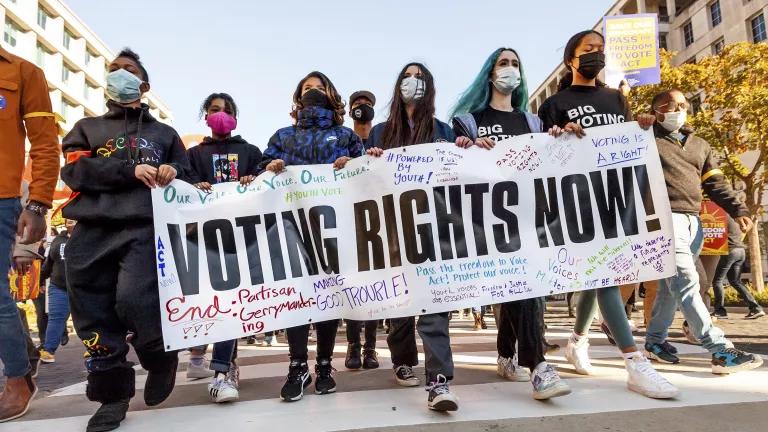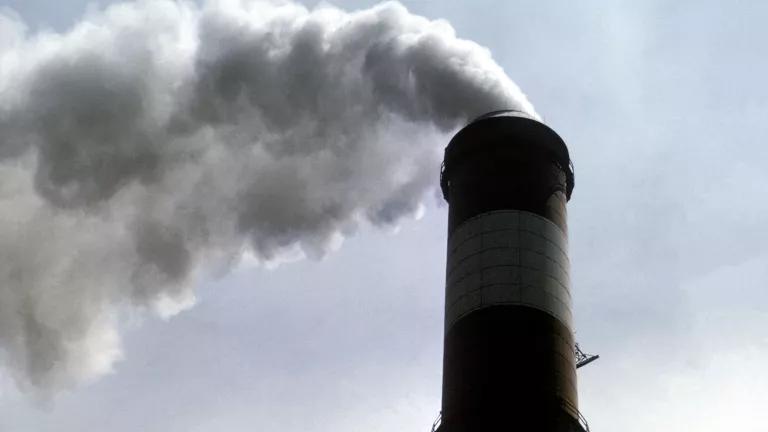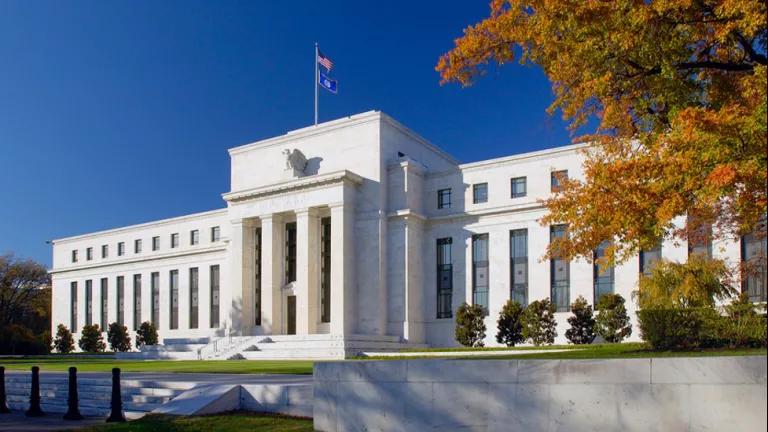Trump Recklessly Formalizes U.S. Withdrawal From the Paris Agreement
President Trump continues to be an outlier on climate change as states, cities, companies, and investors—not to mention 195 other nations—are treating the issue as a real and growing problem they need to address now.

President Trump continues to be an outlier on climate change as states, cities, companies, and investors—not to mention 195 other nations—are treating the issue as a real and growing problem they need to address now.
President Trump has formally notified the United Nations of his plans to withdraw the United States from the historic Paris Agreement on climate change. This notification starts the one-year clock, as the United States wouldn’t be formally out of the agreement until November 4, 2020, under the terms of the accord.
The Paris Agreement marked a critical turning point in efforts to address climate change. It included, for the first time, specific commitments from all major countries and a path to strengthen domestic climate action in the years ahead. This formal step could be reversed by a future administration after 30 days. President Trump has tried—and thankfully failed—to derail the world’s unity to fight climate change.
Today, 195 countries are committed to the Paris Agreement, with 186 of them formally joining it under international law. The only country not in the Paris Agreement? The United States of America under President Trump.
This is a dangerous decision. If it stands, it will isolate and hurt America.
President Trump Is on His Own: Paris Agreement Marches On
When Trump first announced his plans to pull the United States out of the agreement in June 2017, he hoped it would spark a mass exodus. But the opposite occurred: Countries ignored his speeches and continued to push forward. In fact, more nations have joined the Paris Agreement since Trump’s first announcement.

And, more importantly, countries have continued to implement the Paris Agreement.
In December 2018, nations around the world finalized the key rulebook to implement the Paris Agreement. These robust rules include key provisions to help determine whether countries are on track to meet their targets under the agreement. More than 70 countries have committed to enhance their targets by the end of 2020. This includes a number of the most vulnerable countries in the world but also some of the largest emitters, such as those in the European Union, China, Chile, and South Africa. And more than 66 governments, 10 regions, 102 cities, 93 businesses, and 12 investors have committed to achieving net zero carbon emissions by 2050.
American States, Cities, Workers, and Companies Take Charge
Despite the absence of climate leadership from the federal government, the majority of U.S. society is accelerating forward with climate action. The coalition of non-federal actors committed to the Paris Agreement now represents nearly 70 percent of U.S. GDP, 65 percent of the U.S. population, and around 50 percent of U.S. emissions. If this coalition were a country, it would have the world’s third-largest economy after the United States and China. More than 3,800 U.S. states, cities, businesses, investors, and other groups have declared “We Are Still In” to support climate action that achieves the goals of the Paris Agreement.

States in particular continue to demonstrate the transition to a clean energy economy is unstoppable. The U.S. Climate Alliance has grown to a bipartisan coalition of 25 governors committed to reducing emissions in line with the U.S. Paris Agreement pledge to cut emissions 26 to 28 percent by 2025 below 2005 levels.
And more than 200 million Americans—nearly two-thirds of the country—now live in a state with a statewide greenhouse gas emissions reduction target. A total of 29 states and the District of Columbia now have renewable portfolio standards that mandate some percentage of renewable energy generation. These standards have driven approximately half of all renewable energy growth since 2000.
Additionally, a number of states require a specific amount of energy efficiency improvements, and a growing number of states have mandates for zero emissions vehicles and support charging infrastructure.

In terms of state-specific progress, California’s executive order commits it to achieve carbon neutrality as soon as possible—and no later than 2045—and maintain net negative emissions thereafter. In addition, the state’s SB 100 legislation requires its utilities to achieve 100 percent carbon-free energy by 2045.
New York’s recent landmark legislation sets a target for net zero carbon emissions by 2050 and 100 percent carbon-free electricity by 2040. And Nevada, which currently relies on fossil fuels for more than 70 percent of its electricity, recently enacted a bold mandate—50 percent renewable electricity by 2030 and 100 percent clean energy by 2050—with unanimous bipartisan support.
That makes six states, plus the District of Columbia and Puerto Rico, and nine large utilities that are now committed to 100 percent carbon-free power by 2050 or earlier. This means nearly 45 million U.S. homes and businesses are now located in a state or utility service area committed to 100 percent clean energy.
American cities also aren’t waiting to act on climate change. They are solidifying their status as frontrunners of climate solutions. Mayors from more than 400 American cities across 48 states representing over 70 million Americans have committed to uphold the Paris Agreement and accelerate on-the-ground climate action. These cities have taken more than 250 major actions to support more energy-efficient buildings and transportation. And more than 110 U.S. cities have also adopted 100 percent clean electricity goals.
The American Cities Climate Challenge, of which NRDC is a partner, is working with 25 of the biggest, most ambitious cities to develop powerful resources and know-how to beat their near-term carbon reduction goals. The challenge recently released a Climate Action Playbook that found if the top 100 cities implement a set of proven and achievable measures, they could cut emissions by more than 30 percent—the equivalent of taking 47.5 million cars off the road for a year or shutting down 57.5 coal-fired power plants for a year.
There is good reason why these key decision-makers support continued climate action. There are nearly 3.3 million people working in the clean energy sector right now in America. Last year alone, more than 110,000 net new clean energy jobs were created across the country.

Source: E2, Clean Jobs America 2019
American businesses are seizing the opportunities of a low-carbon economy. Nearly 600 American companies have committed to 1,300 individual and cooperative actions to address climate change. Specifically, more than 100 U.S.-based companies have set greenhouse gas emission reduction targets in line with climate science as part of the Science Based Targets initiative. And under the RE100 initiative, more than 150 major global corporations with a combined revenue of $4.5 trillion dollars—over 5 percent of the global GDP—have set 100 percent renewable energy benchmarks. One-third of these corporations are headquartered in North America. These businesses understand the size of the economic prize from acting on climate change. There are $26 trillion in global economic benefits on the table to be won through 2030 as countries move to meet the Paris Agreement targets.
And finally, the American public overwhelmingly supports the Paris Agreement, with 77 percent of registered voters supporting continued U.S. participation, including almost all Democrats (92 percent), three in four Independents (75 percent), and a majority of Republicans (60 percent).
Countries that lead on climate change will be the most competitive in the 21st century, while those that sit on the sidelines risk losing out on huge economic benefits. America’s governors, mayors, workers, companies, and citizens recognize the benefits of climate action even if President Trump sticks his head in the sand.

Two workers installing rooftop solar panels—a gift from India—on the U.N. headquarters building in Manhattan
Mark Garten/UN Photo
The World Steps It Up
The United States played a central leadership role in helping to secure the Paris Agreement, and now Trump is hoping that other countries will slow their climate action. But those other countries aren’t sitting back and waiting.
China’s share of coal in total energy consumption has been falling every year since 2015, from 64 percent in 2015 to 59 percent in 2018 and an estimated 1.7 percent reduction in the first nine months of this year. It has continued to lead the world in wind and solar installation. China’s annual wind and solar installation, almost 65 gigawatts (GW) last year, is more than the United States’, European Union’s, Canada’s, India’s, Japan’s, Korea’s, and Brazil’s combined. Its total installed wind and solar capacity is the largest in the world: about 2.4 times the amount installed in America. And it has the largest amount of electric passenger vehicles and buses on the planet.
India is also on track to meet its Paris Agreement goal to have 40 percent of its installed capacity from non–fossil fuel sources and reduce its emissions intensity by 33 to 35 percent from 2005 to 2030. Non–fossil fuel installed electricity capacity now accounts for 38 percent of installed capacity. India has set a domestic target of achieving 175GW of renewables by 2022. Prime Minister Modi reaffirmed India’s goal to achieve this target and announced that he will further increase its renewable energy capacity to 450GW.

The Fight Will Go On
It is a sad day in America and around the globe. But the fight will go on to ensure that we protect our children and grandchildren from the devastating impacts of climate inaction. Trump may try to take us backward, but America and the world won’t let him get his way.
Climate change is a clearer threat to Americans than it was two years ago. The United States has experienced more than $400 billion in weather and climate disaster costs since 2014. Our economy is on track to lose hundreds of billions of dollars from climate impacts.
Over the last year, we’ve seen three dire reports from the U.N. Intergovernmental Panel on Climate Change warning of severe damage if global temperatures rise by 1.5 degrees Celsius; of already dangerously degraded oceans and ice; and of the disappearing forests that could pull harmful carbon pollution out of the air. Another international scientific report forecast massive die-off of species if we don’t stem the pace of climate change.
The United States was the indispensable leader that cemented the Paris Agreement. It’s the indispensable leader the world needs to meet the growing threats and costs from climate change. The fact is, the federal government must rejoin the Paris Agreement as soon as possible. The unfolding climate crisis demands it. Our children and grandchildren do, too.




